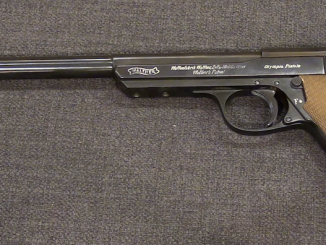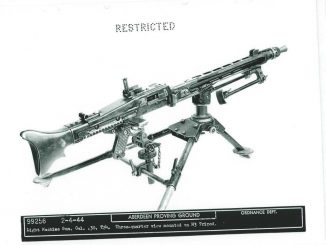Lot 3129 in the September 2019 RIA auction.
First appearing in the decade of so before World War One, the Scheintod guns were designed to fire either flash or irritant cartridges, not lethal projectiles. The word “scheintod”, in fact, translates to something along the lines of “apparent death”, as in something that looks lethal but actually isn’t. They would remain popular as self-defense weapons through the 1920s, and were made in a wide variety of configurations. This one is a particularly large example, with 5 chambers nearly 3 inches in length. It would have fired a round of red pepper, tobacco powder, or other eye and nose irritants.




“The word “scheintod”, in fact, translates to something along the lines of “apparent death”, as in something that looks lethal but actually isn’t. ”
Deutsch Scheintod is actually medical term for Vita reducta or (in simple words) state of organism in which it is not dead and do not give signs of being alive.
“(…)Scheintod guns(…)”
This reminds me modern Russian OSA traumatic weapon: https://modernfirearms.net/en/traumatic-weapons/wasp-r-non-lethal-system-eng/
Though it is more “derringer” than “pepper-box”
As they says: nothing new.
There was a version of the Dutch military issue revolver model 1873 in 9.4mm Dutch service caliber, known as the “tot transgaspatroon”, which had a short smoothbored barrel, no front sight, and was designed for use with a special tear-gas cartridge.
In fact, the “tear gas” revolver was entirely capable of firing standard service ball ammunition, and at short range (three yards or less) the lack of rifling would not be a major handicap to the target collecting the bullet in a sensitive spot.
The “tear gas” revolver and its standard ball-cartridge brethren are illustrated on pp 258-59 of The Handgun by Geoffrey
Boothroyd.
cheers
eon
“New non lethal weapon with a kit for making organic pest-repellent cartridges in your kitchen! No need to risk carrying volatile industrial gasses in your pockets! Order before the week is over and we’ll throw in our new 1500-volt anti-bandit electric gloves with a fresh battery for 25% off! Get these while you can!”
Just kidding!
I can remember reading about these in a now greatly dated book.I apologize for not remembering the name or having a link to said book but it was mentioned that some of the cartridges not only contained an irritant but also some kind of dye. Not unlike what a bank teller puts in with the bag of money during a robbery. It sure would make the mugger easier to identify later on I suspect.
Banker dye is the bank robber’s bane since it won’t wash off easily. Way back in the Roaring 20’s, some banks also had trapdoors of doom right in front of the counter, ensuring a very quick if overly dramatic method of thwarting a robbery. One wonders why we can’t just install bulletproof glass nowadays to prevent over-the-counter bank robberies. Chinese banks have such windows installed… and dimwit robbery attempts sometimes became comedy material as a result, with the tellers laughing at the crook.
There’s a field for an ambitious ammunition collector!
A ‘pepperbox’ in the truest sense of the word.
I see the safety-catch moves up for “fire.” I again postulate that this style of safety was intended to be taken off while the weapon was still holstered, pocketed, or pursed (perhaps not until the trigger was unfolded?), and then pushed down for safe after use but before folding the trigger and putting weapon away. Can this weapon be safed while cocked? Does it have a half-cock?
“12mm, or approximately .410…”
And The Judge is still barely more useful.
Strictly speaking, 12mm is .48in, or just a bit less than .50 caliber (12.7mm).
But in Europe during the pinfire era, cartridges were often “sized” by the case diameter rather than the bore spec. Hence, “12mm” pinfire revolvers that in fact had a semi-bottlenecked case and actually launched a 9mm to 9.5mm bullet.
I wouldn’t be surprised to find that this weapon was marketed as a “12mm” but actually had a bore closer to 10.4mm, which was among other things the standard German service caliber in the M1879 and M1883 Reichsrevolvers. They were listed as 10.6mm but their actual bore diameter was indeed .410″.
cheers
eon
These mass produced particularly by Belgium gun manufacturers, in a variety of revolver pistol type forms and (often) quite large calibers (I have seen reports of up to 20mm). Being particularly marketed to and popular with cyclists – notably to deter dogs (which were apparently a chronic menace).
I think “scheintod” is the ammunition designation,
the weapons were built by different companies.
Here for example from Burgsmueller:
https://www.gas-waffen.de/scheintod-waffen/scheintod-pistole-nr-2/
They are the origin of all blank guns.
https://www.tactical-dad.com/waffen/schreckschusswaffen/